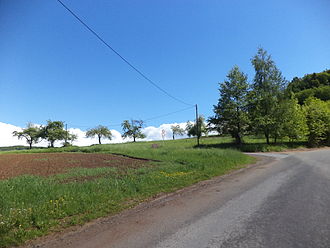Residential town (Mömbris)
Wohnstadt is a deserted area in the Lower Franconian district of Aschaffenburg in Bavaria .
geography
Residential town was located in the middle of Kahlgrund a few hundred meters from the town of Brücken , in what is now the Mömbris market between the Brücken district and the Mömbris sewage treatment plant below the Poisonous Mountain .
history
middle Ages
Around 1350 the settlement was mentioned under the name Nostad . In some old corridor maps, the spelling dwelling also appears. In the vernacular is deserted "Woschert" called. In the Middle Ages , Wohnstadt belonged to the Mömbris court , which in turn was part of the Alzenau free court . The free court was directly imperial , but the empire pledged or lent the area again and again. So the rulers changed, including the lords and later counts of Hanau , the lords of Randenburg and the lords of Eppstein .
Modern times
In 1500 , the Roman-German King Maximilian I enfeoffed the Archbishop of Mainz and the Count of Hanau-Munzenberg together with the Freigericht, which they now administered as a condominium . Since ecclesiastical jurisdiction remained with the Archbishops of Mainz at the time of the condominium , the Reformation - in contrast to the County of Hanau-Münzenberg - could not prevail here. Wohnstadt remained Roman Catholic . 1585 Wohnstadt is mentioned as belonging to the parish of Mömbris. Most of the documentary mentions date from the 17th and 18th centuries, when a residential town was often pledged.
With Count Johann Reinhard III. the last male representative of the Hanau family died in 1736. The Landgrave of Hesse-Kassel was the heir of the Hanau-Münzenberg part of the state by virtue of a treaty . Whether his legacy also extended to Hanau's share in the condominium was heavily disputed in the following years between Kurmainz and Hessen-Kassel. The dispute ended in a compromise, the "party recession" of 1740, which provided for a real division of the condominium. However, it took until 1748 for the treaty to be implemented. As a result, residential town fell to Kurmainz.
The Reichsdeputationshauptschluss of 1803 struck Wohnstadt of the Landgraviate of Hessen-Darmstadt , which however only kept it for 13 years. In 1816 the now Grand Duchy of Hesse ceded the place to the Kingdom of Bavaria .
Leftovers
Today only a small spring, which now serves as a watering place for birds and game, indicates residential town. During the Second World War , when a bomb fell in the area of the meadow that now covers the former settlement area, remains of the village are said to have been blown free. It can therefore be assumed that the desert still exists as a ground monument .
The Wohnstädter Weg in Brücken and the Straße Auf der Wohnstadt at the municipal sewage treatment plant are named after the desert.
More desertions in the region
|
|
|
literature
- Our bald ground . Homeland yearbook for the Alzenau district. Published by the working group for homeland research and homeland maintenance of the Alzenau district, district administrator. ISSN 0933-1328 .
Web links
Individual evidence
- ↑ Our Kahlgrund 1966 . Homeland yearbook for the Alzenau district. Published by the working group for homeland research and homeland maintenance of the Alzenau district, district administrator. ISSN 0933-1328 .
Coordinates: 50 ° 5 ′ 30.9 ″ N , 9 ° 8 ′ 19.8 ″ E
